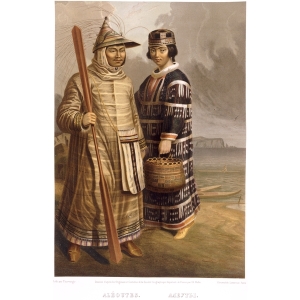If you were one of the 14 (a made-up number) people who read this back when LWON was publishing wonderful posts but was otherwise just a baby staggering around on inept little feet, we apologize for repeating ourselves. Anyway, you probably weren’t. One of the 14.
 Several superb posts on one of my favorite blogs, Elfshot, got me thinking recently about the attire of the earliest migrants to the Americas. Despite all the festering debate over exactly when these hardy travelers set foot in the New World, most evidence suggests that they landed here during the last Ice Age, somewhere between 20,000 and 13,500 years ago. And many researchers think they took a coastal route, nudging gradually along the Pacific Rim from Asia by boat or canoe.
Several superb posts on one of my favorite blogs, Elfshot, got me thinking recently about the attire of the earliest migrants to the Americas. Despite all the festering debate over exactly when these hardy travelers set foot in the New World, most evidence suggests that they landed here during the last Ice Age, somewhere between 20,000 and 13,500 years ago. And many researchers think they took a coastal route, nudging gradually along the Pacific Rim from Asia by boat or canoe.
And this leads to an interesting question. How did they manage to stay warm in the water, avoiding hypothermia in the Ice-Age cold?
Perhaps, just perhaps, they wore waterproof parkas made of sea-mammal gut. At Elfshot, Tim Rast and Lori White have written about some cool experimental archaeology (here andhere), cleaning the carcass of a hooded seal that died of natural causes after giving birth to a pup. The photos and description of cleaning the seal’s intestine might not be for the faint of heart, but I found them both really fascinating. I was particularly amused by Tim’s description of trying to dry out the intestine, cut into three sections, after cleaning out the contents.
“After I squeezed out each section,” wrote Tim, “and ran water through them we inflated them with a mattress pump so that they can dry. We hung the inflated tubes up in my workshop to dry. On the best of days, my job is a little unusual, but stringing those rubbery tubes up in the shed was weird even for me.”
Once dried, Tim added, these rubbery tubes will look nearly translucent– a quality that once made them very useful as “windows” in Inuit snow houses. But this tough material will also be very light and waterproof–ideal for making the ancient equivalent of an outer shell for an expedition parka.
 And this is exactly what the inhabitants of the Aleutian Islands off the northern Alaska coast did in the 19th century. They fashioned beautiful outer garments from sea mammal guts, then popped them over warm birdskin or fur parkas. Apparently historic Aleut men loved these garments known as kamleikas so much that they wore them everyday. (The illustration to the left from the British Museum website shows a very fancy long sea-gut parka (left figure) ; the upper photo, also from the British Museum, shows an actual 19th century Kamleika.)
And this is exactly what the inhabitants of the Aleutian Islands off the northern Alaska coast did in the 19th century. They fashioned beautiful outer garments from sea mammal guts, then popped them over warm birdskin or fur parkas. Apparently historic Aleut men loved these garments known as kamleikas so much that they wore them everyday. (The illustration to the left from the British Museum website shows a very fancy long sea-gut parka (left figure) ; the upper photo, also from the British Museum, shows an actual 19th century Kamleika.)
Ok, I know, we have no way of knowing presently whether prehistoric Aleut men wore these, much less whether the earliest migrants to the Americas. It’s hard enough finding ancient coastal sites as it is, what with the changes in sea level since the Pleistocene, never mind finding traces of organic materials such as sealskin parkas.
But I personally think this is the kind of thing that early coastal travelers could have worn as they nudged their way northward and eastward along the Pacific Rim. And what an ingenious piece of tailoring this is.